Copyright 2012 by Skyhorse Publishing, Inc.
All Rights Reserved. No part of this book may be reproduced in any manner without the express written consent of the publisher, except in the case of brief excerpts in critical reviews or articles. All inquiries should be addressed to Skyhorse Publishing, 307 West 36th Street, 11th Floor, New York, NY 10018.
Skyhorse Publishing books may be purchased in bulk at special discounts for sales promotion, corporate gifts, fund-raising, or educational purposes. Special editions can also be created to specifications. For details, contact the Special Sales Department, Skyhorse Publishing, 307 West 36th Street, 11th Floor, New York, NY 10018 or .
Skyhorse and Skyhorse Publishing are registered trademarks of Skyhorse Publishing, Inc., a Delaware corporation.
Visit our website at www.skyhorsepublishing.com.
10 9 8 7 6 5 4 3 2 1
Library of Congress Cataloging-in-Publication Data is available on file.
ISBN: 978-1-61608-551-3
Printed in the United States of America
PREFACE
 HAT prompted the author to prepare this book was the oft - repeated question, by blacksmiths and mechanics of all kinds, as well as farmers: Is there a book treating on this or that? etc., etc. To all these queries I was compelled to answer in the negative, for it is a fact that from the time of Cain, the first mechanic, there has never been a book written by a practical blacksmith on subjects belonging to his trade. If, therefore, there has ever been such a thing as filling a long-felt want, this must certainly be a case of that kind.
HAT prompted the author to prepare this book was the oft - repeated question, by blacksmiths and mechanics of all kinds, as well as farmers: Is there a book treating on this or that? etc., etc. To all these queries I was compelled to answer in the negative, for it is a fact that from the time of Cain, the first mechanic, there has never been a book written by a practical blacksmith on subjects belonging to his trade. If, therefore, there has ever been such a thing as filling a long-felt want, this must certainly be a case of that kind.
In medicine we find a wide difference of opinion, even amongst practitioners of the same school, in treating diseases. Now, if this is so where there is a system, and authority for the profession, how much more so must there be a difference of opinion in a trade where every practitioner is his own authority. I shall, therefore, ask the older members of the blacksmith fraternity to be lenient in their judgment if my ideas dont coincide with theirs. To the apprentice and journeyman I would say: do as I do until you find a better way.
The author has been eminently successful in his practice, and his ideas have been sought by others wherever he has been, blacksmiths coming even from other States to learn his ways.
This little book is fresh from the anvil, the author taking notes during the day while at work, compiling the same into articles at night.
He is indebted to a number of writers for articles in this book treating on subjects belonging to their trades, in which they have been regarded as experts.
CHAPTER I

THE SMITH
 OR centuries the blacksmith has been a prominent person, and it is natural he should have been, when we consider the variety of work he had to do. From the heavy axle and tire, down to the smallest rivet in the wagon, they were all made by the smith. Bells and bits as well as the ornamental parts of the harness, they were all made by the smith. From the crowbar and spade down to the butcher and pocket knife, they were all made by the smith. The carpenters tools, from the broadax and adz down to the divider and carving steel, they were all made by the smith. From the heavy irons in the fireplace down to the frying-pan and locks on the kitchen doors; knives and forks on the dining-table, they were all made by the smith. From the gun on the shoulder of the soldier and the saber in the hands of the officer, the spurs and pistol for the commander, they were all made by the smith. From the heavy anchor and its chain to the smallest pulley in the rigging of the ship, they were all made by the smith.
OR centuries the blacksmith has been a prominent person, and it is natural he should have been, when we consider the variety of work he had to do. From the heavy axle and tire, down to the smallest rivet in the wagon, they were all made by the smith. Bells and bits as well as the ornamental parts of the harness, they were all made by the smith. From the crowbar and spade down to the butcher and pocket knife, they were all made by the smith. The carpenters tools, from the broadax and adz down to the divider and carving steel, they were all made by the smith. From the heavy irons in the fireplace down to the frying-pan and locks on the kitchen doors; knives and forks on the dining-table, they were all made by the smith. From the gun on the shoulder of the soldier and the saber in the hands of the officer, the spurs and pistol for the commander, they were all made by the smith. From the heavy anchor and its chain to the smallest pulley in the rigging of the ship, they were all made by the smith.

THE SMITH
From the weather vane on the church spire, and the clock in the tower down to the lock of the doors and the artistic iron cross over the graves in the church yard, they were all made by the smith. No wonder, then, that the smith was respected. Vulgar people swear by the devil, religious by the saints, but the Swedes (the makers of the best iron) prefer to swear by the smith. The smith was a well-liked person in society, respected and even admired for his skill, his gentlemanly behavior and good language. His stories and wit were the sole entertainment in many a social gathering. Things have changed in the last few decades. Most of the articles formerly made by the smith are now manufactured by machinery, and the respect for the smith is diminished in the same proportion. Not because there is not enough of the trade left to command respectthere is yet more left than any man can successfully learn in a short lifetime. But it has made it possible for men with less training and ability to enter the trade and consequently lower the standing of the smith. The result is, that there is a complaint that the smith is not esteemed as formerly, and I have been inclined to join in the lamentation. But instead of doing this I shall ask my brother smiths to unite with me in an effort to elevate the craft.
THERE ARE SMITHS AND SMITHS
I have had the pleasure of becoming acquainted with a great number of intelligent and respected smiths. People that did not know them would ask: What is he? and when informed that he is a blacksmith would say: He doesnt look it; I thought he was a business man: another, He looks like a lawyer or a minister. From this you will understand how, in many cases, the blacksmith looks. A great preacher was announced to preach in a neighboring town, and I went to hear him. Just as I sat down in the pew one of the local smiths walked up to me and sat down by my side. He was a blacksmith and he looked it. Under his eyes was a half moon in black; on both sides of his nose was a black stripe that had been there since his first day in the shop. His ears, well, you have seen a clogged-up tuyer iron. His clothes were shabby and his breath a strong mixture of tobacco and whisky, which made wrinkles on the nose of the lady in front of us. I was somewhat embarrassed, but the sermon began. As the congregation arose, I opened the hymnbook and my brother smith joined, and with a hand that looked like the paw of a black bear, he took hold of the book.
After service I was invited by the smith to dinner. Between a number of empty beer kegs we managed to reach the door of the house and everything inside looked the color of his trade. I looked around for books and other articles of culture and found a hand organ and a pack of cards. The only book or reading matter to be found was a weekly of the kind that tells of prize fights, train robberies and murder. I had a fair dinner and told my host that I had to start for home. By this time I was sick of his languageprofanity, mixed with a few other wordsand I started to leave. On my way to the livery stable I passed my friends shop, and he said it would not be fair to leave before I had seen his shop. I have, said he, a very good shop. The shop was a building of rough boards 1820the average farmer has a better wood shed. A big wood block like the chopping block in a butcher shop, was placed so close to the forge that he could only get edgewise between. On this block was to be found, anvil and all his tools, the latter were few and primitive, and would have been an honor to our father Cain, the first mechanic and blacksmith. What thinkest thou, my brother smith? Having spent years to learn the trade you must submit to a comparison with smiths of this caliber. Their work being inferior they must work cheap, and in some, perhaps many, cases set the price on your work. Smiths of this kind cannot expect to be respected. There might be some show for them in Dawson City or among the natives in that vicinity, but not in civilized America.


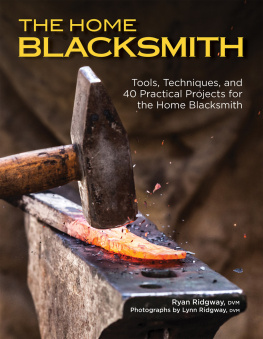
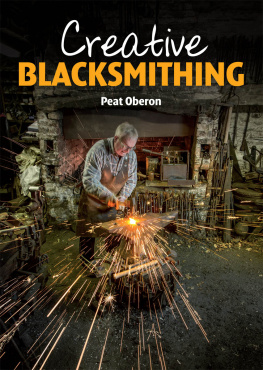
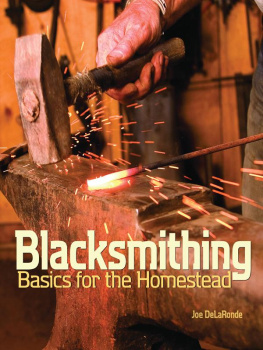
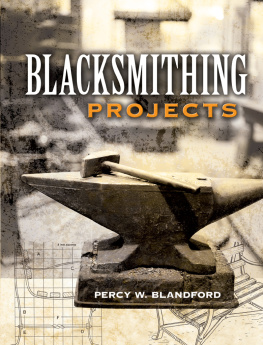
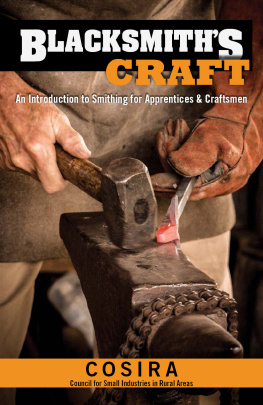

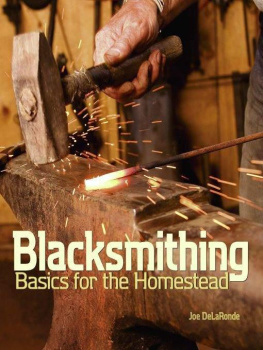

 HAT prompted the author to prepare this book was the oft - repeated question, by blacksmiths and mechanics of all kinds, as well as farmers: Is there a book treating on this or that? etc., etc. To all these queries I was compelled to answer in the negative, for it is a fact that from the time of Cain, the first mechanic, there has never been a book written by a practical blacksmith on subjects belonging to his trade. If, therefore, there has ever been such a thing as filling a long-felt want, this must certainly be a case of that kind.
HAT prompted the author to prepare this book was the oft - repeated question, by blacksmiths and mechanics of all kinds, as well as farmers: Is there a book treating on this or that? etc., etc. To all these queries I was compelled to answer in the negative, for it is a fact that from the time of Cain, the first mechanic, there has never been a book written by a practical blacksmith on subjects belonging to his trade. If, therefore, there has ever been such a thing as filling a long-felt want, this must certainly be a case of that kind.
 OR centuries the blacksmith has been a prominent person, and it is natural he should have been, when we consider the variety of work he had to do. From the heavy axle and tire, down to the smallest rivet in the wagon, they were all made by the smith. Bells and bits as well as the ornamental parts of the harness, they were all made by the smith. From the crowbar and spade down to the butcher and pocket knife, they were all made by the smith. The carpenters tools, from the broadax and adz down to the divider and carving steel, they were all made by the smith. From the heavy irons in the fireplace down to the frying-pan and locks on the kitchen doors; knives and forks on the dining-table, they were all made by the smith. From the gun on the shoulder of the soldier and the saber in the hands of the officer, the spurs and pistol for the commander, they were all made by the smith. From the heavy anchor and its chain to the smallest pulley in the rigging of the ship, they were all made by the smith.
OR centuries the blacksmith has been a prominent person, and it is natural he should have been, when we consider the variety of work he had to do. From the heavy axle and tire, down to the smallest rivet in the wagon, they were all made by the smith. Bells and bits as well as the ornamental parts of the harness, they were all made by the smith. From the crowbar and spade down to the butcher and pocket knife, they were all made by the smith. The carpenters tools, from the broadax and adz down to the divider and carving steel, they were all made by the smith. From the heavy irons in the fireplace down to the frying-pan and locks on the kitchen doors; knives and forks on the dining-table, they were all made by the smith. From the gun on the shoulder of the soldier and the saber in the hands of the officer, the spurs and pistol for the commander, they were all made by the smith. From the heavy anchor and its chain to the smallest pulley in the rigging of the ship, they were all made by the smith.